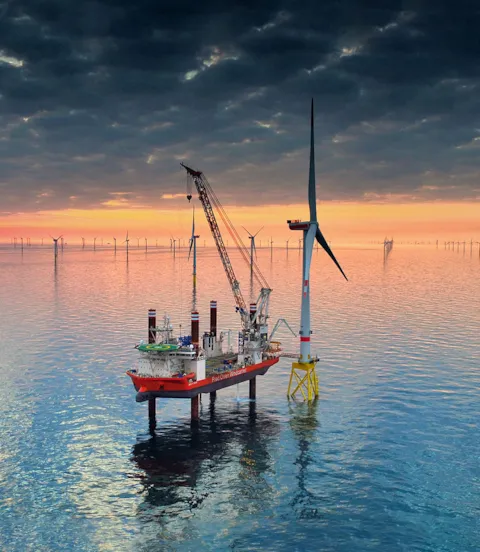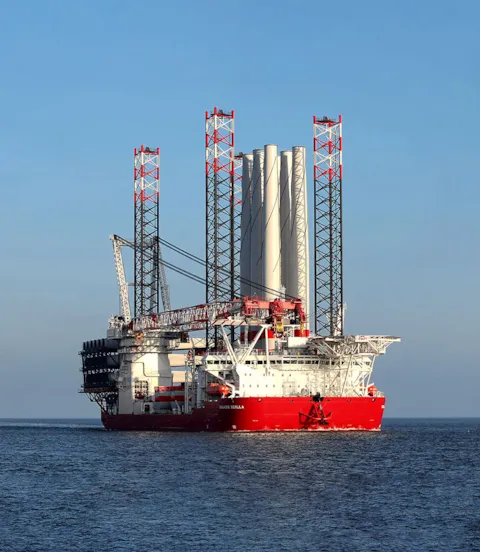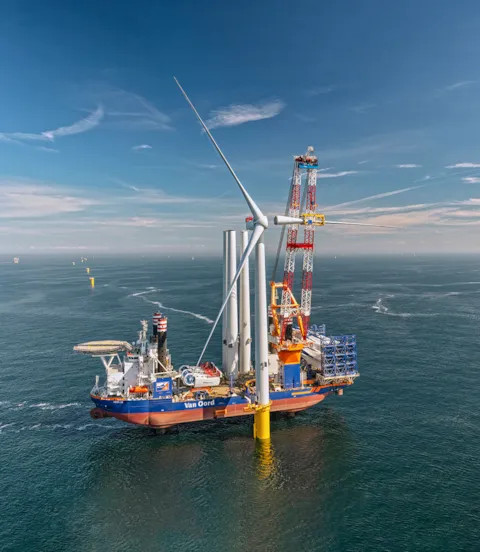Offshore wind: New horizons demand new approach to operations
With space for traditional offshore wind farms dwindling, the offshore wind industry is moving into new territory, further offshore and in harsher environments with less forgiving seabed conditions. In response, the industry has joined forces in a joint industry project (JIP) to consider new operational philosophies and the optimization of operational limits, without compromising on safety.
Growing demand for renewable energy is driving expansion in the offshore wind industry, and space staked out for the first wave of installations is filling up quickly. Nearshore wind farms were the natural first choice, as installation and service is easier in shallow water, and transport shorter from shore. “Now the industry needs to move further out,” confirms Andries Hofman of GustoMSC B.V., steering committee chairman for the newly established Joint Industry Project on Bottom Impact and Partially Submerged Conditions.

Accommodating new offshore wind markets
“Offshore wind is still a relatively small part of the total offshore energy sector, but we are seeing the rapid development of offshore wind worldwide,” says Johannes Ottersen, Senior Engineer, Floating Offshore Structures, DNV GL – Maritime. “The growth markets are in the US and Asia, and further offshore Europe. Offshore wind will only be one part of the global energy mix, but the overall contribution has grown.” Confirmation of global growth comes from project partner CIMC Raffles in Yantai, China: “There is a large market for large-scale wind turbine installation vessels (WTIV) in China, with some orders already being negotiated. Those WTIVs will work on new wind farms, with water depths of 50–65 m and in harsher environments,” says Fu Qiang, head of R&D at Yantai CIMC Raffles Offshore. “Operating in semi-jacked condition has been used in wind turbine installation in China, and we will need more such operations in the future. We have performed some analysis on bottom impact, but we have lacked comparisons with actual data. We also need a reasonable assessment methodology. For this reason, CIMC Raffles is pleased to participate in the JIP research to enhance the performance of the WTIV design.”

Managing new operational scenarios
Jack-up rigs are employed during the installation of offshore wind turbines. Bottom impact occurs when the jack-up legs strike the seabed. “Installation rigs sail to site with the jack-up legs in a raised position. In the transition period, while lowering the legs into the support position, the vessel experiences movements such as heave and roll,” Hofman explains. “This movement affects the depth of the legs, and they regularly come into contact with the sea floor. Soft soil provides less impact. Hard soil provides resistance, and can cause considerable impact. With future wind farm locations, we expect to encounter a larger variation in soil conditions than seen so far.”
Geert Weymeis, Installation Analysis Teamlead Offshore at project partner Jan De Nul Group, concurs: "The phase of bottom impact and transition from floating to elevated is often a critical part of the operation, however at present the limitations are not well understood. Through this JIP, we are aiming to gain a better understanding of the phenomena that play a part which in turn will lead to optimized and safer operations."
Harsher weather conditions further offshore compound the problem, Hofman relates. “Stronger winds and higher waves can exaggerate bottom impact events, and increased impact can potentially damage not only the rig, but also cargo. We sail to the site with up to 100 m turbine towers on deck, so we need to manage bottom impact to the fullest degree possible.”
The aim is to fill market needs in the years ahead, he adds. “We will see continued use of jack-ups, and we want to operate safely, but we have to push the boundaries of weather window and bottom conditions in order to expand operations.”

Defining jack-up rig limits
“It comes down to the survival characteristics of the rig,” says Hofman. “Prior to each project, the operator needs to prove that they can work safely on a particular site. Each site is different, so how can they demonstrate this? Soil investigations and environmental data are part of the picture, but we have to match these to the design capabilities of the unit.”
Therein lies a key task for the JIP, he explains. “We are addressing a desire to achieve a unified approach, and meet the need for predictability. Most stakeholders do not want to rely on a single company for their information. This also motivates class to move beyond design and into the marine operational phase.” Improved understanding of the interaction between jack-up legs and the soil is needed, including the effect of water depth. “Ships behave differently in shallow water, and we need to be sure of the magnitude of impact. The JIP will review general methodology to capture basic principles and allow operators to analyse each individual situation with sufficient confidence.”

Setting standards for the analysis of leg bottom impact and semi-jacked conditions
“Jack-ups have to relate to weather limits in the leg set-down phase, and this can lead to long ‘waiting for weather’ periods. This is a cost factor in the wind turbine industry, where they are performing installations at new sites virtually every day,” says Ottersen.
Further analysis is needed in order to fully understand leg bottom impact, he says. “Class approves the weather limitation, but there is no common way to perform analysis, and class society guidelines are lacking. Operational procedures were traditionally considered to be at the captain’s discretion, relying on their seamanship and knowledge. Now we are trying to define a standard that incorporates vessel heading and sea states, taking into consideration different vessel motions and soil conditions.”
The JIP will explore and propose procedures and provide background on how to perform analysis, Ottersen says, with the aim of delivering clearer acceptance criteria and requirements for safety. “We have always set operational limits, but based on simplified assessments. What is new is a growing interest in increasing the operation time through more advanced calculation methods and increased computing capacity.”
Franck Legerstee of the Technical department in Deme offshore, part of Deme Group, backs up this observation: “A number of our upcoming projects involve operations in longer wave periods which results in higher vessel motions and consequently higher leg impacts. A guiding industry standard to ensure safe and efficient operations in these conditions has been missing, and we see in this research project a great opportunity to provide the grounds for a unified and globally accepted approach to support safe operations.”

JIP puts operational safety first
“DNV GL is honoured to arrange this project, and we have seen that participants highly appreciate having this arena to share knowledge and move the industry forward,” says project manager Antonio Goncalves, Advisory Services at DNV GL – Maritime. “We are happy to see so many players joining the JIP. This provides a high value for both the project and the partners. We have buyers and suppliers across the value chain assembled in the same room, sharing experience and knowledge in order to establish new procedures and acceptance criteria.”
Pushing boundaries in a safe way is highly important, Andries Hofman notes. “The ultimate goal of this JIP is to make operations safer, and it is very heartening to see the industry uniting behind this goal. The project partners are also competitors or stakeholders with different objectives, but in the JIP we are joining forces to ensure safer operations.”
Speaking on behalf of OceanWinds, Construction Manager and Installation Work Group Coordinator Pedro Pereira and his colleague Pablo Alberte add: "It is necessary for the offshore wind industry to continue the move into areas with harsher soils and weather conditions, where ingenuity and a common industry approach are required to uphold safety and performance. This JIP and the participants have answered the challenge in full."

Standard approach for safe deployment of WTIVs
The results of the first JIP investigations are due in early 2021 , Hofman says, with those results determining the timeline for the remainder of the project. “I believe this will represent a significant organic development in the industry. This requirement has been evolving since the early 2000s, as the number of operations has increased and the need for operational standards is ramping up. We have been safe to date, but now awareness is growing of the risk, as boundaries will have to be pushed in order to increase energy capacity.”
He has support from Kevin Drake, Principal Specialist, Noble Denton marine services, DNV GL – Oil & Gas: “The joint industry project represents an important step towards the development of a standard approach for a consistent industry-wide assessment of risks for the safe and efficient deployment of WTIVs,” he confirms.
“The involvement and contribution of all parties so far has been extremely positive,” Antonio Goncalves concludes. “With such a strong team and good collaboration, I am very confident that the JIP will provide high value for all parties, helping us in our contribution to achieving a sustainable energy future.”
Project partners: DEME Offshore, DNV GL, Fred. Olsen Windcarrier, GustoMSC, Jan De Nul, Ocean Winds, Ørsted, Seajacks UK, Van Oord Offshore Wind, Yantai CIMC Raffles Offshore

Antonio Goncalves
Business Lead
- Fred. Olsen Windcarrier/CHPV Offshore Filming & Photography
- Seajacks
- Van Oord
- DEME Group